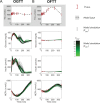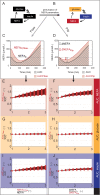Model-Based Quantification of the Systemic Interplay between Glucose and Fatty Acids in the Postprandial State
- PMID: 26356502
- PMCID: PMC4565650
- DOI: 10.1371/journal.pone.0135665
Model-Based Quantification of the Systemic Interplay between Glucose and Fatty Acids in the Postprandial State
Abstract
In metabolic diseases such as Type 2 Diabetes and Non-Alcoholic Fatty Liver Disease, the systemic regulation of postprandial metabolite concentrations is disturbed. To understand this dysregulation, a quantitative and temporal understanding of systemic postprandial metabolite handling is needed. Of particular interest is the intertwined regulation of glucose and non-esterified fatty acids (NEFA), due to the association between disturbed NEFA metabolism and insulin resistance. However, postprandial glucose metabolism is characterized by a dynamic interplay of simultaneously responding regulatory mechanisms, which have proven difficult to measure directly. Therefore, we propose a mathematical modelling approach to untangle the systemic interplay between glucose and NEFA in the postprandial period. The developed model integrates data of both the perturbation of glucose metabolism by NEFA as measured under clamp conditions, and postprandial time-series of glucose, insulin, and NEFA. The model can describe independent data not used for fitting, and perturbations of NEFA metabolism result in an increased insulin, but not glucose, response, demonstrating that glucose homeostasis is maintained. Finally, the model is used to show that NEFA may mediate up to 30-45% of the postprandial increase in insulin-dependent glucose uptake at two hours after a glucose meal. In conclusion, the presented model can quantify the systemic interactions of glucose and NEFA in the postprandial state, and may therefore provide a new method to evaluate the disturbance of this interplay in metabolic disease.
Conflict of interest statement
Figures








References
-
- Johanson EH, Jansson P-A, Gustafson B, Lönn L, Smith U, Taskinen M-R, et al. Early alterations in the postprandial VLDL1 apoB-100 and apoB-48 metabolism in men with strong heredity for type 2 diabetes. J Intern Med. 2004;255: 273–279. - PubMed
-
- Cassader M, Gambino R, Musso G, Depetris N, Mecca F, Cavallo-Perin P, et al. Postprandial triglyceride-rich lipoprotein metabolism and insulin sensitivity in nonalcoholic steatohepatitis patients. Lipids. 2001;36: 1117–1124. - PubMed
-
- Kirkman MS, Shankar RR, Shankar S, Shen C, Brizendine E, Baron A, et al. Treating Postprandial Hyperglycemia Does Not Appear to Delay Progression of Early Type 2 Diabetes The Early Diabetes Intervention Program. Diabetes Care. 2006;29: 2095–2101. doi: 10.2337/dc06-0061 - DOI - PubMed
-
- Lefebvre P, Scheen A. The postprandial state and risk of cardiovascular disease. Diabet Med. 1998; S63–68. - PubMed
-
- Borén J, Taskinen M-R, Adiels M. Kinetic studies to investigate lipoprotein metabolism. J Intern Med. 2012;271: 166–173. doi: 10.1111/j.1365-2796.2011.02497.x - DOI - PubMed
Publication types
MeSH terms
Substances
LinkOut - more resources
Full Text Sources
Other Literature Sources
Molecular Biology Databases

